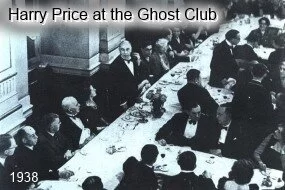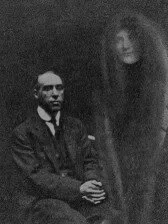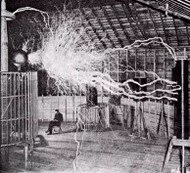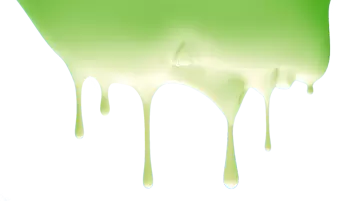by Marlon
 Whether in an attempt to scare up intrigue or for actual scientific inquiry, our collective interest in ghosts is wildly on the rise. From major TV shows like Ghost Adventures, Ghost Hunters and Paranormal State to a mystifying number of websites, paranormal research societies and ghost book publishers; it is hard to partake in fringe pop culture without running into some element of ‘ghost-culture’ today.
Whether in an attempt to scare up intrigue or for actual scientific inquiry, our collective interest in ghosts is wildly on the rise. From major TV shows like Ghost Adventures, Ghost Hunters and Paranormal State to a mystifying number of websites, paranormal research societies and ghost book publishers; it is hard to partake in fringe pop culture without running into some element of ‘ghost-culture’ today.
Yet ghost hunting and researching the paranormal is by no means a modern or isolated occurrence. The genesis of ghost hunting, it turns out, lies far deeper in our past than the modern advent of EMF meters, digital recorders, infrared devices or full-spectrum cameras.
So where does it all begin?
Beyond the Veil: What History Reveals
In modern times we conceptualize ghost hunting as a technology-driven, immersive activity centered on pitch-black excursions in auspicious or ‘active’ locations. The general stated purpose of most ghost hunts (beyond getting the heart racing) is to discover the ‘truth’ and unearth evidence that could make believers out of non-believers.
It turns out; however, this is by no means a mere modern desire.
Indeed, it’s no stretch to believe that as long as humans have lived and died, there has been interest in understanding what lies beyond the veil. After all, death is truly a final frontier of sorts: It’s the one place we all go, yet the one place we cannot say for certain ‘where’ or ‘what’ it is. With such a question looming, it’s no wonder why theories of ghosts, deities and the “other side” have pervaded nearly every culture through time.
But this doesn’t answer where modern ghost hunting enters the scene. At what point did we leave behind stories, myths and superstitions for the joys of séances, dressing up and scientific pursuit? Alas, a question worth digging for.
The Science of Spooky
According to novelist James Houran, our modern approach to ghost hunting began with the marriage of science and religion. Houran suggests that while Enlightenment philosophers thought reason and science would trump superstition and religion, mystical beliefs instead created a bond with scientific inquiry. Rather than replacing one paradigm with another, the birth of modern science coincided with the hybridization of two prevailing trains of thought that persist even today. In sum, ghosts and science are not mutually exclusive.
Houran points to the mesmerism of the late eighteenth century as an early example of this unlikely mix of beliefs. While Franz Mesmer was a physician and self-proclaimed member of the Enlightenment, Mesmer’s followers often associated his work with clairvoyance. Simply put, his work started in the realm of medicine and in many instances, ended in the realm of mysticism.
 “A similar cult developed around electromagnetism in the 1820s and 1830s,” writes Houran, “in which electricity was revered as a divine universal principle. This fusion of religion and science characterized much of nineteenth-century mysticism.”
“A similar cult developed around electromagnetism in the 1820s and 1830s,” writes Houran, “in which electricity was revered as a divine universal principle. This fusion of religion and science characterized much of nineteenth-century mysticism.”
Spiritualism, which emerged in the 1850s in the wake of reported poltergeist activity in an American home, represented the next step in this evolution. Houran writes that according to the spiritualists of the time, it was believed that the soul could be empirically quantified through science. Enter the quintessential picture of dapperly dressed séance parties and mediums speaking in tongues in candlelight, and you get the picture.
Then as now, people were curious and sought by the scientific means at hand – the technologies and methods of the time – to provide proof and definitions for their experiences. Be sure and see: Spirit Photography
Bridging the Gap
Fast forward a few centuries to modern times. Houran asserts that the amateur ghost hunter of today represents a “variation of the techno-mysticism stretching back at least two centuries in Western culture,” where ‘techno-mysticism’ is “the investing of technological objects and processes (such as photography and radio) with magical or supernatural properties.”
Since technology is an extension of science, our modern methods for untangling the mysteries of the afterlife represent a natural progression since the Enlightenment. For anyone who’s watched a ghost hunt on television today, our heavy reliance on technology in modern situations implicitly states our trust in science, and anchors our assertions of “proof” and “evidence” in technology itself. Dare we say, “In technology we trust?”
 Electricity: The Purveyor of the Paranormal
Electricity: The Purveyor of the Paranormal
Underlying our preoccupation with technology and science as a means for investigating the paranormal is one central and omnipresent force – electricity!
Time and again, electricity plays back into the narrative of ghost hunting and exploring the paranormal. Novelist Lloyd Auerbach offers a contemporary example of the interaction of electricity, electromagnetism and paranormal forces that typifies the reasoning behind this theory.
Pointing to the work of Dr. Michael Persinger of Laurentian University in Canada on the effects of electromagnetism on the brain, Auerbach recounts that “Several correlations were found, indicating that as the Earth’s magnetic field goes up and down, both globally and in a given area, people report varying types of psychic experiences.” While these findings by no means support the existence of ghosts, they do reflect the effects of electricity on perception and the brain.
This begs the question: If perceptions can be manipulated by electricity, could a disembodied entity utilize electricity to communicate or effectively ‘paint a picture’ for the observer? While this is wild speculation, it certainly does tie into the use of electronic devices for paranormal investigations, and the manipulation thereof by unseen forces, to support the existence of ghosts through technological means.
A Live Wire? (Pun Intended)
While hundreds of years separate us from the nineteenth century cults of mysticism cited by Houran, it appears that the presence of electricity and electromagnetism as a “divine universal principle” is if nothing else a piece in the modern puzzle for understanding our methods for ghost hunting (and perhaps the reliability of our evidence).
Most certainly this piece of the puzzle is anchored to the Enlightenment and birth of modern science, but perhaps most clearly, it suits the world we live in today more now than any time before. Any way you cut it, as long as there are theories on ghosts, there will be clear lines drawn to our past – lines that our continued reliance on technology won’t soon allow us to forget as we march ever forward into this brave new world of discovery.
Works Cited
Auerbach, L. (2003). Ghost Hunting: How to Investigate the Paranormal. Oakland, Ca: Ronin Publishing.
Houran, J. (2004). From Shaman to scientist: Essays on humanity's search for spirits. Lanham, Md: Scarecrow Press.
Marlon works for the website, HalloweenCostumes.com

